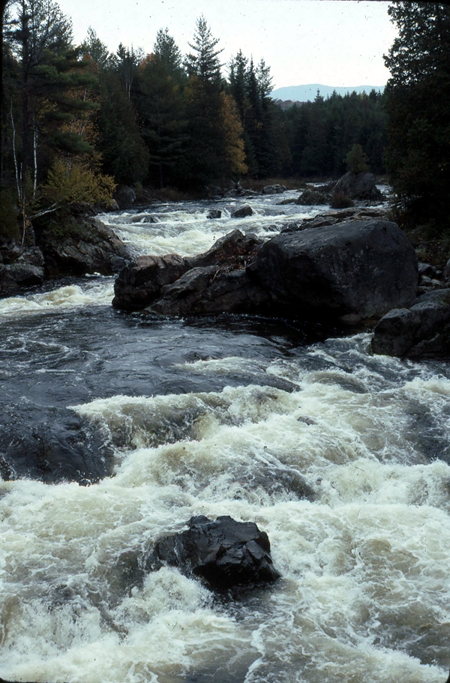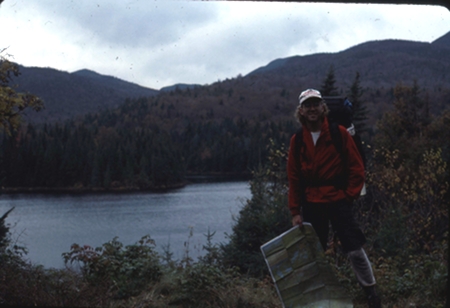Cold River and Moose Pond: Traverse of the High Peaks Wilderness

November, 1992: I’d just copied this from The Prophet, by the Lebanese poet Kahlil Gibran: “And forget not that the earth delights to feel your bare feet and the winds long to play with your hair.”
The correct way to test that hypothesis, obviously, was via a grueling, 50 mile hike through the Adirondacks’ High Peaks region. And as the autumn entered its wan, second half, that’s what we did.
The moon was full the evening before we entered the Adirondack park, after - as usual - a long drive northward and eastward from Ithaca, and a night stuffing as much of Dave’s mom’s fantastic cooking in our bellies as we could. Autumn was becoming early winter, but what we wanted wasn’t green canopy over our heads, but the perfect isolation of wilderness, and a chance to soak in the scents and sounds of the world. With boots laced up and bags strapped on our backs, we set off walking through birches that looked yellow and tired, and set our sights on the far side of the empty woods. Leaves were still falling, but there was more color pooled around our feet than over our heads. Above us, the empty boughs conspired to let in the light of the late autumn moon.

From Shattuck Clearing, Duck Hole lie a full 12 miles uphill and 500 feet higher in elevation. We walked it mostly in the valley of - and alongside - the Cold River. It was the largest river I’d ever had the pleasure of meeting, and I got to know it in the tradition of the Adirondacks: by dipping a steel camper’s cup into it and taking a long drink. Every hiker knows that’s risky, but the map showed clearly there was nothing upstream but mountainous wilderness, and the water was clean, clear, and delicious. And of course: cold! By mid-day, aching legs required a rest, and we paused to snack next to the tumultuous waters of a small waterfall, where sharp rocks had been cut smooth by years of running water, now channeled into a boisterous fury by the shape of the land. Already, we felt exposed to a sense of harmony you don’t sense in the places most shaped by humans. Above us, framed on both sides by the stiletto tops of the pines, was a canvas of grey, cool, autumn sky. There was a still beauty to it, but it looked unforgiving.
We tramped wearily to Duck Hole, where our trail guide had described the little lean-to as dirty and worse for the wear. No hiker I know would see fit to complain about such a welcoming sight at the end of a long hike! Duck Hole lie at 2180 feet, a dark patch of silver wedged between sharp peaked mountains and a cold sky. At one end, a small water fall gurgled as Duck - and the other two Preston Ponds - drained southward into the Cold River through a fast-flowing stream. Out towards the center, a little islet stood forested with pines and inhabited by nothing but rabbits and raccoons.[1] The kindness of strangers: some previous hiker had left us a store of some dry food.

Our third day of hiking led us through a narrow gorge past water channels with names like “Roaring Brook.” Moose Pond was truly remote, with the rugged, Sawtooth Mountains on one side, at over 3500 feet, and Street and Nye Mountains behind its back, towering at over 4000 feet. On all sides, it was forest. We arrived just as storm clouds broke over the Sawteeth, and with nothing to do but relax before rustling up some dinner, we kicked up our boots and watched nature take its course.
It’s hard to underestimate the wilderness of this part of the Adirondacks. I don’t recall seeing a single other hiker the entire week. The lateness of the season clearly had something to do with it, but this stretch of the Adirondacks is truly remote. We cooked a meal to be proud of that evening: beef stew, clam chowder, tomato rice with fried, sweet red peppers and onions, homemade mashed potatoes with butter and au gratin potatoes, followed by apple sauce. Packs lightened, we relaxed around the fire, reading Patrick McManus stories from a paperback while the wood burned down to embers. But Moose Pond had some surprises for us: as we finished setting up sleeping bags, I let out a little wolf call. Immediately it was answered: coyotes, on all sides of us, and not too far away. We had been watched: for how long? As the forest returned to silence, the fire guttered, and night was upon us.
A storm passed through that night, leaving us a bit weather-beaten but glad for the shelter that had kept us dry. As we packed our bags and prepared for the final march northwards towards Lake Placid, we surveyed the peaks around Moose Pond. On the other side, the Sawtooth Mountains gleamed with newly-fallen snow. Time to walk. Our track began to descend. Having traversed the watershed, the water was flowing northward now, into the Chubb River and toward Lake Ontario. We passed the lovely but somewhat over-visited Wannika Falls. The valley flattened, the trail turned muddy and soft, and as we descended we reached Averyville Road, where my jeep was still waiting for us. Home then, down the long, concrete highway back to Ithaca and the real world of obligations and schoolwork and society, our taste of the wilderness still fresh on our souls.

[1] Turns out, the landscape around Duck Hole has been altered permanently by Hurricane Irene, which destroyed the dam and drained the pond.
Trackbacks
The author does not allow comments to this entry

Comments
Display comments as Linear | Threaded